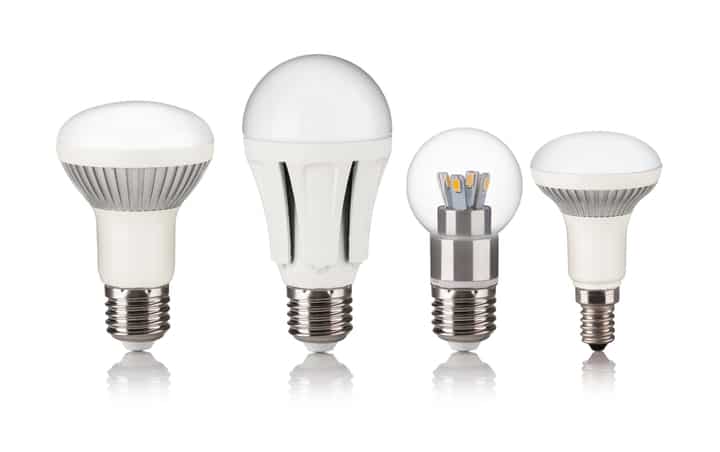Worried that your innocent LED lights are secretly plotting to turn you into a tan goddess or god? While they might be great at brightening up your room, they’re not exactly in the business of granting you a beachy tan.
You might have heard rumors that LED light bulbs emit UV radiation.
Only LEDs designed to emit UV radiation give off high levels of UV energy. Standard LED light bulbs don’t emit UV radiation, or any other kind of harmful radiation, close to harmful levels.
So you can relax – your new white light LEDs aren’t going to give you skin cancer.
In this guide I’ll explain:
- More about LED lights and UV emissions
- The types of radiation emitted by most LED light bulbs
- Why most artificial light sources don’t emit harmful UV rays
Do LED Lights Emit UV Rays?
Blue light wavelengths used in some white light LEDs do emit UV rays but the phosphor coating of the light stops the UV rays emitting from the bulb.
Even if the phosphor inside LEDs is damaged, and the blue and UV light shines through, it’s not enough that it’ll cause serious health risks.
If a manufacturer claims that their LED lights produce no UV rays, it’s probably just because the amount is so minimal that they can get away with classifying it as zero.
Do LED Lights Emit Radiation?
LED lighting does produce electromagnetic radiation – an Extra Low Frequency (ELF) field. It’s caused by the driver managing the current, stepping it down to the level needed by a light emitting diode. It’s an insignificant amount.
The electricity which is not used is sent back through the wires, and during this process, dirty electricity is produced, leading to Extra Low Frequency (ELF) EMF radiation.
In other terms, this refers to the amount of electricity that “travels” along power lines in which only standard 50/60 Hertz AC electricity should be. So, any other amount of electricity which is not in this frequency is what we call dirty electricity.
What Type Of Light Emits UV Rays?

There are some artificial lights that emit UV radiation, but nowhere near as much as the natural sun. Examples of an artificial light that emits significant UV radiation include:
- Tanning lights
- Reptile basking bulbs
- Fluorescent bulbs
- Incandescent bulbs
These are bulbs that are actually designed to emit UV, because of their purpose.
Tanning bulbs can be made using brilliant blue LEDs, though they need to be special ones. Obviously, they give off UV energy because that’s how they tan your skin.
Reptile basking bulbs aren’t typically LEDs because they’re designed to produce heat. Usually, they’ll be a halogen or incandescent light bulb.
There are some other kinds of lights that we use in our lives that can emit a higher amount of UV radiation than LEDs, too.
Fluorescent lights, including fluorescent tube lighting and compact bulbs, emit more UV than LED lighting. CFL bulbs emit enough that you should avoid spending any time within 25 cm of them.
Beyond that range, the radiation dissipates to a safe level.
Some types of car headlamps need special coatings too, in order to capture the UV rays and only emit the visible light you want to illuminate the road. High Intensity Discharge bulbs (HIDs) are one such example.
Do Incandescent And Halogen Bulbs Emit UV?
Incandescent bulbs emit a similar level of UV energy to LEDs. Halogens generate much more UV energy but are protected by the quartz coating on the bulb, so they are both safe to use at home.
As the halogen lights work at a very high temperature, they emit considerable UV rays and give off less infrared radiation.
This is why halogen lamps have to be provided with special casings to avoid UV radiation and help protect us from harmful UV light.
Older incandescent light bulbs and halogen lights are being phased out now, due to being less energy efficient than LED lighting. Still, if you have these older bulbs at home, you don’t need to worry about any harmful impact on your skin.
FAQ
Can LED Lights Cause Sunburn?
Standard LED lights for your home can’t cause sunburn – they don’t emit enough UV radiation to harm you. You can get special tanning bulbs made using LEDs and these can, of course, burn you if you use them too long.
Is LED Light The Same As UV Light?
LED lighting and UV lights are completely different. LEDs are a type of light bulb or light source, while UV is a wavelength of light produced by some types of bulb. LEDs primarily create white light (or colored light, for some LEDs).
Do LED Black Lights Emit UV?
LED black lights do emit a long wavelength form of UV radiation, but it’s not harmful in short doses. If you were to hold the light facing you for long periods of time, it could be dangerous, but using a black light as intended is safe.
Final Words
Just like any other lights in your home, LED lamps aren’t going to produce enough UV to harm you.
Imagine if, after installing LED lights, you were constantly getting sunburned – they wouldn’t be able to manufacture them!
LEDs are safer than some older lights, such as fluorescent light bulbs, since they produce such a minimal amount of UV.
Only special bulbs, such as LED tanning lights, produce UV at a potentially dangerous level.
If you want special LED lighting to help grow plants, check my guide on that next.
Looking for an LED bulb but not sure what type you need?
Check out my free bulb picker and select the right bulb within few clicks.




Comments are closed.